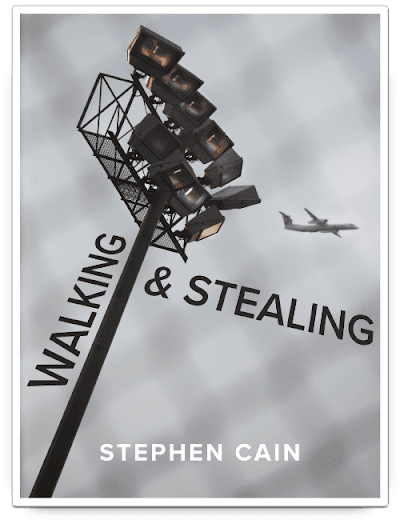Stephen Cain, Walking & Stealing
No! I am not MadameCezanne
Nor was meant to be
Those wine bottles inyour neighbour’s garden
Have they begun tosprout?
The Art of Work in theAge
Of Mechanical Oppression
A future right turn
Overwhelm your comfortzone
A lyric in flight (“CANTOONE”)
 Thereis something curious about the accumulating distances between full-lengthcollections by Toronto poet, editor and critic Stephen Cain, from the relatively quickappearance of his first three full-length collections every couple of years—
dyslexicon
(Toronto ON: Coach House Books, 1998),
Torontology
(Toronto ON: ECW,2001) and
American Standard/Canada Dry
(Coach House Books, 2005)—to thelonger wait-times that emerged with
False Friends
(Toronto ON: BookThug,2017) [see my review of such here], and now,
Walking & Stealing
(Toronto ON: Book*hug Press,2024). Some of us have been waiting, sir.
Thereis something curious about the accumulating distances between full-lengthcollections by Toronto poet, editor and critic Stephen Cain, from the relatively quickappearance of his first three full-length collections every couple of years—
dyslexicon
(Toronto ON: Coach House Books, 1998),
Torontology
(Toronto ON: ECW,2001) and
American Standard/Canada Dry
(Coach House Books, 2005)—to thelonger wait-times that emerged with
False Friends
(Toronto ON: BookThug,2017) [see my review of such here], and now,
Walking & Stealing
(Toronto ON: Book*hug Press,2024). Some of us have been waiting, sir. Therearen’t too many poets these days in Canada working through poems to see wherethe language might land or extend, offering the next steps in a conversation aroundpoetics that seems to have quieted down over the past decade. Through Walking& Stealing, Cain offers himself as example of the standard-bearer foran exploration of thought and form, continuing a trajectory of sound andmeaning collision, playfully battering around a lyric too often staid or safe. Wherehave all the language poets disappeared to? With so many poets of the aughtseither shifted in poetic or publishing far less (if at all), Cain almost existsas a central Canadian counterpoint, one might say, to the west coast poetics offurther still-standing poets Clint Burnham [see my review of his latest here]or Louis Cabri [see my review of his latest here], all pushing furthervariations on a language-play through social commentary, countless quickreferences, and deliberate collision. “Canada Post- / Ashkenazi Anishinaabe,”he writes, as the eighth section of the nine-part “CANTO THREE,” “Two nationsunder clods / Anti-Semitism & assimilation // Fuck breathing fire / Spitsparks instead // Almost cut my fear / Flying my antifa flag // Smoke ‘em whenyou see them [.]” Are there any poets on this side of the country, still,referencing the work of Dorothy Trujillo Lusk (I would suggest there should bemore, certainly)?
Foryears, Cain was engaged in book-length sequences and stretches composed acrossten sections, a kind of decalogue of extended language structures, whereas Walking& Stealing exists as a triptych that breaks down into further sections—theseventeen sections, some of which are broken into further sections, of “Walking& Stealing,” the ninety-nine short sections of “Intentional Walks,” and thenine “CANTOS” sequences of “Tag & Run.” The geographic composition points,setting the moment to the music of language, is an interesting mapping acrossCain’s Toronto, almost an echo of bpNichol’s The Martyrology: Book 5(Toronto ON: Coach House Press, 1982), a book I know that Cain himself haswritten extensively on, or Lynn Crosbie’s legendary “Alphabet City” abecedarianfrom Queen Rat: New and Selected Poems (Toronto ON: Anansi, 1998) [see my brief note on such here], a book that should have won all the awards afterit first appeared. The mapping of Cain’s Toronto becomes, if not directsubject, a kind of backdrop and prompt, allowing the landscape of his city tobreathe into the animation of his language. From the opening sequence, listento the poem “Stan Wadlow Park (2017/08/12),” as the second section/half writes:
Map the Moores
Lede line locations
Also Etrog the obelisks
Opposing the ovarianobjects
Short & sequesteredin
Scarborough
No more sinister thanSarnia
Oshawa obeisance
Adolescent anxiety
accumulators
Score on the fly
Beach bleacher bingo
Blanket the yield
Walking & stealing
Whatwas once propulsive has evolved into something more meditative, akin to a kindof walking-text, comparable to works by Stacy Szymaszek [see my review of their latest here], Meredith Quartermain[see my review of her latest here] or Bernadette Mayer [see my review of one of her more recent titles here]; Cain the flaneur, perhaps, but meandering not through thelyric narrative but across a field of language. “Articulate the known-lines,”he writes, as part of the opening sequence, “Map the Masonic / Toronto Chthonic[.]” As he offers as part of his “Notes” at the back of the collection:
Walking & Stealing is a longserial poem composed over the summer of 2017. Each section was composed at apark in Toronto & the GTA between innings of games in which my son, aPeewee AA ballplayer, was pitching & fielding. The composition time of eachsection is the length of a game, & the first draft of each section was recordedin a notebook in the shape & design of a baseball. While the impetus &origin of the poem is juvenile sports, baseball is not so much the subject ofthe poem, but the site & event that allows the poem to arise as I exploreduration, association, & subjectivity. The game of baseball also functionsas an analogue for poetic exploration; for example, the title of the poemrefers to plays in baseball (two ways in which one can gain a base withouthitting a ball), but also to psychogeographic perambulation & “stealing” aspoetic intertextuality.



